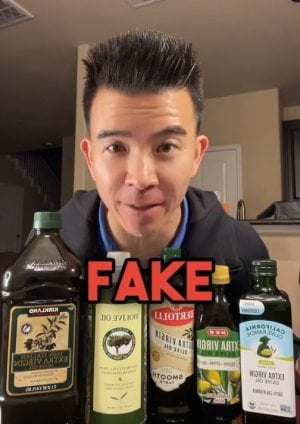5 Shocking Signs Your Olive Oil Is a Fake - Protect Yourself From Expensive Imitations Hiding in Your Pantry!
- Replies 13
In the culinary world, olive oil is akin to liquid gold, a staple in the kitchen that can elevate a simple dish to a gourmet experience. But what if the olive oil you trust to drizzle over your salad or to cook your favorite recipe is not what it seems? With the rise in olive oil prices, fraudsters have found a lucrative market in selling counterfeit olive oil, leaving many consumers with subpar products. Here at the Seniors Discount Club, we want to ensure that our members are well-informed and can protect themselves from these expensive imitations. Let's dive into the five shocking signs that your olive oil might be a fake.
1. The Taste Test: Trust Your Palate
The first and most immediate way to detect a fake is by tasting it. Real extra virgin olive oil should have a distinct flavor profile that includes peppery and bitter notes, with a hint of fruitiness and sweetness. If your olive oil lacks flavor or tastes flat, it could be a sign that it's been diluted with tasteless, refined oils. Take a small sip, swirl it around your mouth to coat your tongue, and pay attention to the flavors – or lack thereof.
2. Label Lingo: Read the Fine Print
The label on your olive oil bottle can reveal a lot about its authenticity. In the UK, genuine extra virgin olive oil must be labeled as 'Superior category olive oil obtained directly from olives and solely by mechanical means.' Look for this exact wording. Additionally, a 'Protected Designation of Origin' (DOP) seal indicates that the oil comes from a specific region with stricter testing standards. The more detailed the information on the bottle, such as the grower's name, the olive variety, and the harvest date, the more likely it is to be genuine.

3. The Price Point: If It's Too Good to Be True...
High-quality olive oil comes with a cost. If you find a bottle of 'extra virgin' olive oil at a price that seems too good to be true, it probably is. The production of authentic olive oil is a labor-intensive process that justifies its premium price. Be wary of bargains and remember that in the world of olive oil, you often get what you pay for.
4. The Container: Avoid Clear Bottles
Exposure to light can degrade the quality of olive oil, so genuine producers tend to package their oil in dark bottles to protect it from light. If your olive oil comes in a clear bottle, it's more susceptible to spoilage, and it may indicate that the producer is cutting corners elsewhere, too.
5. Certification and Approval: Look for the Seal
Reputable olive oils often have certifications from recognized authorities. In the United States, look for approval from the California Olive Oil Council (COOC) or the North American Olive Oil Association (NAOOA). Internationally, the International Olive Council (IOC) provides a seal of approval indicating that the oil has passed laboratory testing.
How NOT to Test Your Olive Oil
Beware of the 'fridge test' circulating on social media. The claim is that real olive oil will solidify in the fridge, while fake oils will not. However, this test is unreliable as not all genuine olive oils will solidify at refrigerator temperatures, and some adulterated oils may still congeal due to their composition.
In conclusion, while the only way to be 100% certain of your olive oil's authenticity is through laboratory testing, these tips can help you make an educated guess. Remember, the best defense against olive oil fraud is to be an informed consumer. Always taste your oil, scrutinize the label, consider the price, check the packaging, and look for official certifications.
 We'd love to hear from you, members! Have you ever encountered fake olive oil? What are your tips for ensuring you're getting the real deal? Share your experiences and advice in the comments below, and let's help each other enjoy the true taste and benefits of genuine olive oil.
We'd love to hear from you, members! Have you ever encountered fake olive oil? What are your tips for ensuring you're getting the real deal? Share your experiences and advice in the comments below, and let's help each other enjoy the true taste and benefits of genuine olive oil.
1. The Taste Test: Trust Your Palate
The first and most immediate way to detect a fake is by tasting it. Real extra virgin olive oil should have a distinct flavor profile that includes peppery and bitter notes, with a hint of fruitiness and sweetness. If your olive oil lacks flavor or tastes flat, it could be a sign that it's been diluted with tasteless, refined oils. Take a small sip, swirl it around your mouth to coat your tongue, and pay attention to the flavors – or lack thereof.
2. Label Lingo: Read the Fine Print
The label on your olive oil bottle can reveal a lot about its authenticity. In the UK, genuine extra virgin olive oil must be labeled as 'Superior category olive oil obtained directly from olives and solely by mechanical means.' Look for this exact wording. Additionally, a 'Protected Designation of Origin' (DOP) seal indicates that the oil comes from a specific region with stricter testing standards. The more detailed the information on the bottle, such as the grower's name, the olive variety, and the harvest date, the more likely it is to be genuine.

Experts highlight five key signs to identify genuine olive oil, including taste and bottle labelling. Credit: Tiktok / Patrick Hu
3. The Price Point: If It's Too Good to Be True...
High-quality olive oil comes with a cost. If you find a bottle of 'extra virgin' olive oil at a price that seems too good to be true, it probably is. The production of authentic olive oil is a labor-intensive process that justifies its premium price. Be wary of bargains and remember that in the world of olive oil, you often get what you pay for.
4. The Container: Avoid Clear Bottles
Exposure to light can degrade the quality of olive oil, so genuine producers tend to package their oil in dark bottles to protect it from light. If your olive oil comes in a clear bottle, it's more susceptible to spoilage, and it may indicate that the producer is cutting corners elsewhere, too.
5. Certification and Approval: Look for the Seal
Reputable olive oils often have certifications from recognized authorities. In the United States, look for approval from the California Olive Oil Council (COOC) or the North American Olive Oil Association (NAOOA). Internationally, the International Olive Council (IOC) provides a seal of approval indicating that the oil has passed laboratory testing.
How NOT to Test Your Olive Oil
Beware of the 'fridge test' circulating on social media. The claim is that real olive oil will solidify in the fridge, while fake oils will not. However, this test is unreliable as not all genuine olive oils will solidify at refrigerator temperatures, and some adulterated oils may still congeal due to their composition.
In conclusion, while the only way to be 100% certain of your olive oil's authenticity is through laboratory testing, these tips can help you make an educated guess. Remember, the best defense against olive oil fraud is to be an informed consumer. Always taste your oil, scrutinize the label, consider the price, check the packaging, and look for official certifications.
Key Takeaways
- Cases of olive oil fraud have increased to record levels in Europe due to rising prices.
- Experts provide five key signs to identify real olive oil, including taste and bottle labelling.
- Olive oil fraud typically involves mislabelling lower-quality oils or adulterating with cheaper oils.
- Popular tests like the 'fridge test' shared on social media are unreliable for verifying olive oil authenticity.







